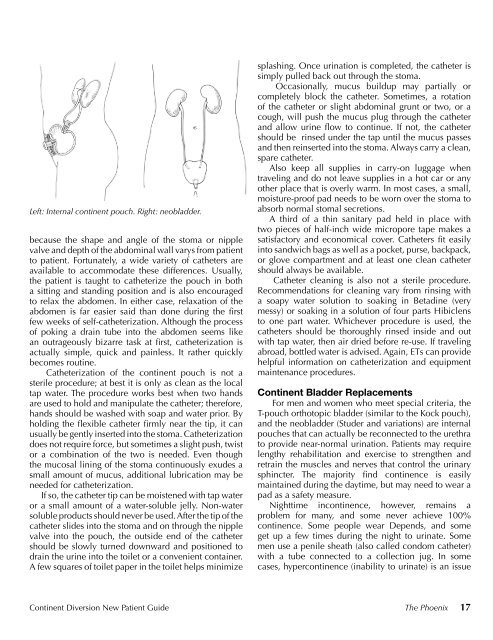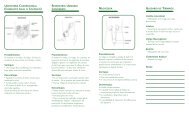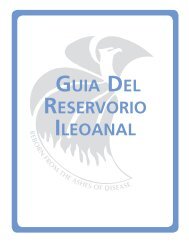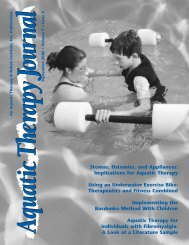Continent Diversion - United Ostomy Associations of America
Continent Diversion - United Ostomy Associations of America
Continent Diversion - United Ostomy Associations of America
You also want an ePaper? Increase the reach of your titles
YUMPU automatically turns print PDFs into web optimized ePapers that Google loves.
Left: Internal continent pouch. Right: neobladder.<br />
because the shape and angle <strong>of</strong> the stoma or nipple<br />
valve and depth <strong>of</strong> the abdominal wall varys from patient<br />
to patient. Fortunately, a wide variety <strong>of</strong> catheters are<br />
available to accommodate these differences. Usually,<br />
the patient is taught to catheterize the pouch in both<br />
a sitting and standing position and is also encouraged<br />
to relax the abdomen. In either case, relaxation <strong>of</strong> the<br />
abdomen is far easier said than done during the fi rst<br />
few weeks <strong>of</strong> self-catheterization. Although the process<br />
<strong>of</strong> poking a drain tube into the abdomen seems like<br />
an outrageously bizarre task at fi rst, catheterization is<br />
actually simple, quick and painless. It rather quickly<br />
becomes routine.<br />
Catheterization <strong>of</strong> the continent pouch is not a<br />
sterile procedure; at best it is only as clean as the local<br />
tap water. The procedure works best when two hands<br />
are used to hold and manipulate the catheter; therefore,<br />
hands should be washed with soap and water prior. By<br />
holding the fl exible catheter fi rmly near the tip, it can<br />
usually be gently inserted into the stoma. Catheterization<br />
does not require force, but sometimes a slight push, twist<br />
or a combination <strong>of</strong> the two is needed. Even though<br />
the mucosal lining <strong>of</strong> the stoma continuously exudes a<br />
small amount <strong>of</strong> mucus, additional lubrication may be<br />
needed for catheterization.<br />
If so, the catheter tip can be moistened with tap water<br />
or a small amount <strong>of</strong> a water-soluble jelly. Non-water<br />
soluble products should never be used. After the tip <strong>of</strong> the<br />
catheter slides into the stoma and on through the nipple<br />
valve into the pouch, the outside end <strong>of</strong> the catheter<br />
should be slowly turned downward and positioned to<br />
drain the urine into the toilet or a convenient container.<br />
A few squares <strong>of</strong> toilet paper in the toilet helps minimize<br />
splashing. Once urination is completed, the catheter is<br />
simply pulled back out through the stoma.<br />
Occasionally, mucus buildup may partially or<br />
completely block the catheter. Sometimes, a rotation<br />
<strong>of</strong> the catheter or slight abdominal grunt or two, or a<br />
cough, will push the mucus plug through the catheter<br />
and allow urine fl ow to continue. If not, the catheter<br />
should be rinsed under the tap until the mucus passes<br />
and then reinserted into the stoma. Always carry a clean,<br />
spare catheter.<br />
Also keep all supplies in carry-on luggage when<br />
traveling and do not leave supplies in a hot car or any<br />
other place that is overly warm. In most cases, a small,<br />
moisture-pro<strong>of</strong> pad needs to be worn over the stoma to<br />
absorb normal stomal secretions.<br />
A third <strong>of</strong> a thin sanitary pad held in place with<br />
two pieces <strong>of</strong> half-inch wide micropore tape makes a<br />
satisfactory and economical cover. Catheters fi t easily<br />
into sandwich bags as well as a pocket, purse, backpack,<br />
or glove compartment and at least one clean catheter<br />
should always be available.<br />
Catheter cleaning is also not a sterile procedure.<br />
Recommendations for cleaning vary from rinsing with<br />
a soapy water solution to soaking in Betadine (very<br />
messy) or soaking in a solution <strong>of</strong> four parts Hibiclens<br />
to one part water. Whichever procedure is used, the<br />
catheters should be thoroughly rinsed inside and out<br />
with tap water, then air dried before re-use. If traveling<br />
abroad, bottled water is advised. Again, ETs can provide<br />
helpful information on catheterization and equipment<br />
maintenance procedures.<br />
<strong>Continent</strong> Bladder Replacements<br />
For men and women who meet special criteria, the<br />
T-pouch orthotopic bladder (similar to the Kock pouch),<br />
and the neobladder (Studer and variations) are internal<br />
pouches that can actually be reconnected to the urethra<br />
to provide near-normal urination. Patients may require<br />
lengthy rehabilitation and exercise to strengthen and<br />
retrain the muscles and nerves that control the urinary<br />
sphincter. The majority fi nd continence is easily<br />
maintained during the daytime, but may need to wear a<br />
pad as a safety measure.<br />
Nighttime incontinence, however, remains a<br />
problem for many, and some never achieve 100%<br />
continence. Some people wear Depends, and some<br />
get up a few times during the night to urinate. Some<br />
men use a penile sheath (also called condom catheter)<br />
with a tube connected to a collection jug. In some<br />
cases, hypercontinence (inability to urinate) is an issue<br />
<strong>Continent</strong> <strong>Diversion</strong> New Patient Guide The Phoenix 17








